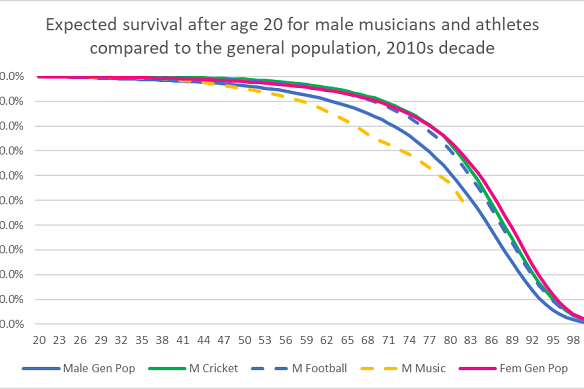By Angus Dalton
Examine, a free weekly newsletter covering science with a sceptical, evidence-based eye, is sent every Tuesday. You’re reading an excerpt – Sign up to get the whole newsletter in your inbox.
In the depths of lockdown in 2021, Dr John Orchard busted his boredom by pursuing a question about death: do AFL players outlive the general population?
That question also led Orchard, a sport and exercise physician at the University of Sydney, to study the lifespans of cricket players and then analyse the mortality rates of Australian rock and pop stars.

A mural in Tel Aviv commemorating musicians who died at 27, including Jimi Hendrix, Janis Joplin and Amy Winehouse.Credit: Wikimedia
Are the tragic early deaths of well-known figures – from Amy Winehouse to Shane Warne – representative on a broader level? Does the famed “27 Club” effect exist in Australia, and does elite sport offer a longevity boost?
Orchard’s results answer these questions and offer a worthwhile lesson in how to interpret mortality data.
Olympians, AFL stars and average Joes
We already know Olympians live longer than the people watching at home. One study found US Olympians outlive general folk by five years thanks to lower risks of cardiovascular disease and cancer. (The health blow a dip in the Seine might inflict on this year’s contenders is yet to be observed.)
In keeping with previous studies on athlete longevity, Orchard’s analysis of almost 10,000 professional AFL and VFL players between 1970 and 2021 found they had a standardised mortality ratio of 0.79. That means they’re 21 per cent less likely to die at any one time, on average, compared to people of the same age and gender in the general population.
Sheffield Shield cricket players, analysed in a follow-up study, were 29 per cent less likely to die.
So despite headline-grabbing cases such as Shane Warne, who died aged 52 of a heart attack, athletes are generally outliving the general population “by a significant margin”, Orchard says.

Paris Mayor Anne Hidalgo swims in the River Seine after her vow that it would be clean for the Olympics.Credit: AP
The obvious influence on athletes’ longevity is exercise. A study of more than 116,000 people in Circulation over 30 years found people who exercised between five and 10 hours a week lowered their risk of death by 26 to 31 per cent.
“If you’re someone who goes out and regularly exercises every week of your life, you’ll live longer,” Orchard says. “That applies for elite athletes and the average Joe.”
The regimented life of an athlete may have a benefit beyond training regimes. Footy players in the headlines for cocaine possession and the odd doping scandal might create the perception that drug use is ubiquitous in the sports world, but generally, the opposite is true, Orchard says.
“Elite athletes are one of the rare groups in society that do get regularly drug tested as part of their work.

Expected survival rates after the age of 20 for the general population (blue for men, pink for women) compared to male rock and pop musicians, cricketers and AFL players.Credit: Orchard et al
“They’re like airline pilots in that sense that they almost certainly have lower drug use than the general population because they know they’re subjected to regular drug tests.”
The ‘27 Club’ effect
But what of those who pick up microphones rather than cricket bats?
For his latest study, Orchard and his colleagues examined the lifespans of Australian rock and pop musicians. Compared to the general population, they had a 35 per cent higher mortality rate.
Alcohol, smoking and illicit drug use are probable reasons for this increased risk of death, which mostly manifests as an increased risk of cancer in middle age.
It’s an assumption that drugs and alcohol play a role, but perhaps a fairly safe one. Jazz, classical, blues and country musicians from the early 20th century didn’t die earlier than the general population, one study found, whereas rock, pop and hip hop musicians from the 1960s onwards did, presumably because of the live-hard die-young lifestyle associated with those genres.

The real Amy Winehouse at her last live concert in Belgrade in June 2011.Credit: Getty Images
“It’s rock and pop that has the negative association,” Orchard says. “If you’re a violinist in the Sydney Symphony, that doesn’t apply to you.”
Orchard also sought evidence of a “27 Club” effect in Australian music, which refers to a cluster of musicians who died at 27, including Jim Morrison, Jimi Hendrix, Kurt Cobain and Janis Joplin.
“The concept of the 27 Club got renewed interest when Amy Winehouse died,” he says. “If you’re in the 27 Club, it’s going to be a misadventure or drug overdose because it’s so rare to die of cancer or heart attack at 27.”
But beyond ACDC’s Bon Scott, who died at 33, and INXS frontman Michael Hutchence, who died at 37, very few Aussie musicians in the study had died under 40. No Australian musicians in the study had died at 27.
That backs up previous research that found the idea artists are more likely to die at 27 is purely a cultural myth, not borne out in the statistics.
What does this tell us about interpreting death data?
The fact pop and rock stars have a 35 per cent greater chance of death while cricketers are 29 per cent less likely to die might sound dramatic. But when you convert these percentages to actual years of life lost or gained, the effect seems less severe.
“Pop and rock musicians live on average two or three years shorter, and athletes live on average two or three years longer,” Orchard says. “So it’s not as much as you’d think.”
The Lancet’s latest report on global life expectancy offers another example. All-cause mortality rates spiked by an unprecedented 21.9 per cent for men and 16.6 per cent for women between 2019 and 2021 due to COVID-19. But the overall drop in life expectancy was only 1.6 years.
That’s because age exerts the greatest effect on anyone’s risk of death. If your risk of death at 40 years old increases by 50 per cent, for example, the risk itself is still extremely low. Your chance of death doubles, but your expected lifespan doesn’t halve.
“Statistics can be laid in different fashions to make you more or less concerned,” Orchard says.
“An 80-year-old athlete is still way, way more likely to die than a 60-year-old musician because your main risk, by far, is age.”
Examine, a free weekly newsletter covering science with a sceptical, evidence-based eye, is sent every Tuesday. You’re reading an excerpt – sign up to get the whole newsletter in your inbox.